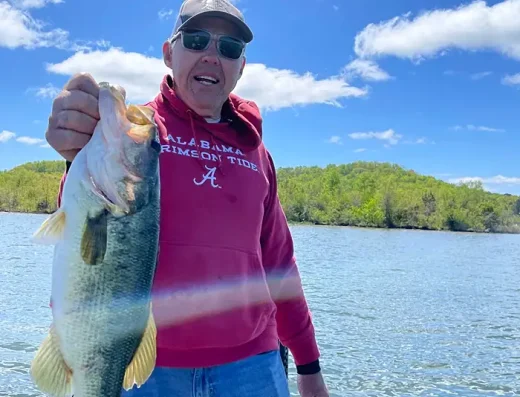Scottsboro Fishing Guides
Scottsboro fishing Guides give anglers access to Lake Guntersville’s famed grass mats, ledges, and creek channels for bass, crappie, and catfish.
Top Rated Guides in Scottsboro
TrustedFish connects anglers with proven local captains in Scottsboro, Alabama —no commissions, no pay-to-play listings, no BS. Every charter on our platform is invite-only, vetted for skill, local knowledge, and reputation. If they’re listed, they’ve earned it.
Scottsboro, AR Fishing Guide
Scottsboro sits on the western edge of Lake Guntersville, a 69,000-acre Tennessee River reservoir known nationwide for its largemouth bass fishery. Charter trips here are almost entirely freshwater focused, with half-day and full-day options tailored to bass, crappie, or catfish depending on the season. While there’s no saltwater access, the lake fishes like a giant backcountry system, with weedy flats, submerged timber, creek mouths, and ledges providing structure year-round.
Popular ramps include Goose Pond Colony, Mink Creek, and Jackson County Park. Most runs are short—less than 15 minutes from the dock to the first cast. Guides know how to position clients on seasonal bite zones, whether that’s flipping jigs into milfoil in April, dragging crankbaits along summer ledges, or jigging deep for winter crappie.
Techniques shift by target species. Largemouth bass anglers rely on chatterbaits, Texas rigs, swimbaits, and topwaters in spring and fall. During the heat of summer, deeper water calls for big worms, Carolina rigs, and crankbaits. Crappie trips favor small jigs and live minnows fished vertically around brush and pilings. For catfish, most guides use cut shad or chicken liver fished on bottom near channel bends.
Even without coastal access like Hampton Bays or Freeport, this region rivals saltwater fisheries in consistency and trophy potential. Whether you’re a tournament angler chasing double-digit bass or a casual group looking for action with slabs or channel cats, local guides in this area know how to deliver.
Fishing Seasons in Scottsboro
Spring
Spring kicks off the peak fishing season as water temps rise and bass move into shallow grass, staging to spawn. This is prime time for flipping and frogging heavy cover, and sight-fishing becomes possible in clear back bays. Crappie also school up shallow around brush, docks, and flats, aggressively hitting jigs or live minnows. Expect high catch rates and hard-hitting fish. March through May is among the busiest charter seasons, and experienced captains often book out weeks in advance.
Summer
Summer fishing shifts the action offshore. Largemouth bass follow bait schools to deeper ledges, humps, and brush piles, where they’re targeted with deep-diving crankbaits, big worms, and Carolina rigs. Early mornings and twilight hours offer the best topwater action, especially when bass chase shad to the surface. Catfish become more active during the warmer months, with cut bait producing steady results in main-lake holes and river channels. Midday heat can be tough, so many charters run dawn-to-lunch trips.
Fall
Fall brings cooling temperatures and baitfish migrations into the creeks, which in turn fire up the bass bite. Topwater lures, spinnerbaits, and lipless cranks dominate, especially around grass points and coves. Crappie school up again on deep brush and docks, often holding 8–15 feet deep depending on the lake level. September through November is an excellent time to fish, with stable weather and less boat traffic than spring or summer.
Winter
Winter fishing is slower-paced but productive for anglers who know how to work ledges and deeper structure. Largemouth bass bite best on jigging spoons, jerkbaits, and shaky heads near channel breaks and rocky points. Crappie stack tightly around deeper docks and submerged brush, hitting downsized jigs and minnows fished vertically. It’s a good time for fewer crowds, solitude on the water, and a shot at trophy fish if you’re patient with the bite.
Gamefish in Scottsboro
- Largemouth Bass – 2 to 10+ lbs Caught year-round. Targeted with swimbaits, chatterbaits, jigs, and crankbaits around grass beds, docks, and main-lake ledges.
- Crappie – 0.5 to 2 lbs Best in spring and fall. Fished using small jigs or live minnows near brush piles, docks, and submerged cover.
- Catfish – 3 to 50+ lbs Active in summer and fall. Targeted with cut bait or live bait along channel edges and deep holes.
- Bluegill – 0.25 to 1 lb Found near shoreline cover and docks. Easily caught with worms, crickets, or small jigs—ideal for family trips.
Scottsboro Fishing FAQs
What types of fishing trips can I book in Scottsboro?
Most trips focus on freshwater species like bass, crappie, and catfish, with half-day and full-day options available.
Where do fishing charters usually launch from in the area?
Common launch points include Goose Pond Colony, Mink Creek, and Jackson County Park—each with fast access to prime zones.
Do I need to bring my own fishing gear?
No—guides typically provide all necessary rods, reels, tackle, and bait. You’re welcome to bring personal gear if preferred.
When is the best time to fish in Scottsboro?
Spring and fall are top choices for bass and crappie action. Summer is great for catfish and offshore patterns.
Are fishing licenses required?
Yes, anyone 16 or older needs an Alabama freshwater fishing license. These can be purchased online in advance.
How long are most fishing trips in this region?
Half-day trips are common (4–5 hours), with full-day trips also available. Most travel times to the fishing spot are under 15 minutes.
Can families or kids join these trips?
Absolutely. Local captains often run kid-friendly trips targeting easy species like bluegill or schooling crappie.
Are we allowed to keep the fish we catch?
Yes. Crappie and catfish are typically kept and cleaned by your guide. Bass are often released, especially larger fish.
How far is Scottsboro from nearby fishing towns like Hampton Bays?
Yes, winter offers excellent ice fishing opportunities on local lakes for trout and landlocked salmon.

